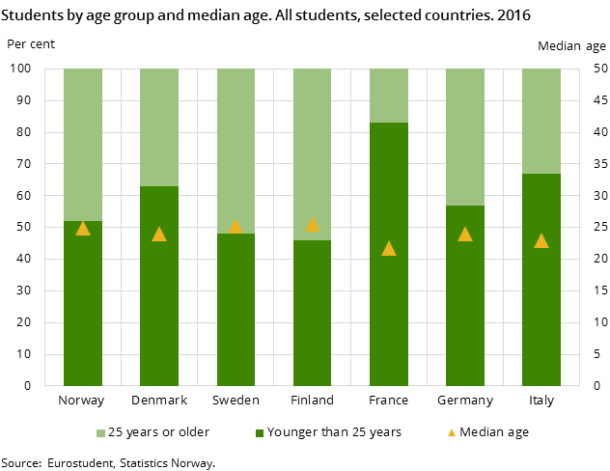Did you know these facts about students in Norway?
Published:
Students in Norway differ from students in many other European countries. In Norway, there are more older students, it is less common to live at home with parents, and students spend a lot of time on paid work.
- Series archive
- Eurostudent survey
The patterns we find in Norway are also in evidence in the other Nordic countries, as results from the Eurostudent survey show. Did you know, for example, that…
Every second student is aged 25 or over
The median age of students in Norway is 25 years. As figure 1 shows, just over half of the students in Norway are below the age of 25. Every fourth student in Norway is 30 years or over. Norway differs from countries such as France, where 4 out of 5 students are above the age of 25, and where the median age of students is only 22 years.
Students in Italy and Germany are also somewhat younger than students in this country. Comparing Norway to the other Nordic countries, we see that also in Finland and Sweden, more than half of the students are 25 years or over. The exception in the Nordic context is Denmark, which includes only full-time students in the survey. In the other Nordic countries, part-time students are also included, and the share of part-time students increases with students’ age. At the same time, we know that it is common for students to take a break after completing their upper secondary education, which can also explain differences in students’ age between countries. Twenty per cent of students in Norway have taken a break of more than two years before starting their studies, and this is also common among our Nordic neighbours.
Norway does not only differ in the age distribution of students, but is also among the countries with the highest share of female students – 6 out of 10. Read more about students in Norway and learn what they study here. Are you interested in learning more about students with impairments? Find out more about this group here.
Only 10 per cent live with their parents
Students in Norway are not only older than students in other countries, their housing situation also differs. Every tenth student in Norway lives with his or her parents, and the comparable figure in Denmark, Finland and Sweden is also below 15 per cent, as shown in figure 2.
Figure 2. Share of students living with their parents. All students, selected countries. 2016
| Norway | Sweden | Denmark | Finland | Italy | France | Germany | |
| Living with partents | 9 | 13 | 8 | 4 | 69 | 33 | 21 |
| Not living with parents | 91 | 87 | 92 | 96 | 31 | 67 | 79 |
This is in contrast to Italy, where 7 out of 10 students live with their parents. It is also common for students aged 30 and over to live with their parents in Italy, while in Norway practically none of the oldest students live with their parents. Differences between countries can be related to cultural differences and distances to the learning institutions, but can also be due to variations in the financial support available to students in the different countries.
Even though it is not common for students in Norway to live with their parents, many students live with other persons. It is most common to live with a partner and/or children, with 1 in 3 students in Norway having this housing situation. Do you want to know more about how students in Norway live and how satisfied they are with their housing situation? Read here.
Many students receive public student support
Students in Norway have a high median income compared to students in many other European countries. The composition of different income sources varies, however, between countries. Figure 3 shows the share of students who receive public student support, and the public student support as a share of recipients' total income. In Norway, 80 per cent of the students not living with their parents receive support from the Norwegian State Educational Loan Fund (Lånekassen). It is also common in the other Nordic countries and in France for students to receive public student support. However, this is not the case in Germany and Italy, where only 27 and 17 per cent respectively receive public student support. Among the students in Norway receiving public support, this support represents 60 per cent of their total income. This type of support is also an important source of income in the other Nordic countries. In Sweden, public support accounts for 70 per cent of the total income of the recipients of such support. In France, on the other hand, a lot of students receive public support, but this only accounts for 40 per cent of the total income of the recipients, and in Italy, the share is 50 per cent.
This means that other sources of income are important. In Germany, France and Italy, family support is an important income source. In the Nordic countries, on the other hand, students are more economically independent from their families, and the income from paid work is the most important source of income. Here you can read more about students’ resources and expenses.
Students in Norway spent more time on paid work than students in other countries
Income from paid work is an important income source for many students in Norway, and this reflects the fact that it is common for students in Norway to have paid work alongside their studies. More than 40 per cent of students have paid work during the entire semester. On average, students in Norway spend 12 hours a week on paid work, which is more than students in the other Nordic countries and in France, Germany and Italy. In Italy, students work an average of just 5 hours a week, and it is less common to have paid work. Only 1 out of 10 students in Italy work during the entire lecture period, as shown in table 1.
Table 1. Share of students with paid work during the entire semester. All students, selected countries. 2016
| Norway | Denmark | Sweden | Finland | France | Germany | Italy | |
|---|---|---|---|---|---|---|---|
| Working during the whole lecture period | 41.7 | 36.3 | 27.7 | 28.7 | 21.0 | 54.1 | 11.4 |
| Working from time to time during the lecture period | 24.9 | 25.4 | 20.7 | 22.8 | 23.3 | 17.4 | 12.5 |
| Not working during the lecture period | 33.4 | 38.3 | 51.6 | 48.5 | 55.7 | 28.5 | 76.1 |
Source: Eurostudent., Statistics Norway.
Although it is common to work in Norway, this does not mean that students spend less time on study-related activities compared to students in other countries. However, there are differences in how time spent on studies is divided between time spent on taught studies and personal study activities. Figure 4 shows that the combined workload of studies and paid work is fairly equal in the different countries, varying between 40 hours a week in Sweden and 45 hours a week in Denmark.
Figure 4. Time spent on study-related activities and paid work. Mean per week, hours. All students, selected countries. 2016
| Norway | Denmark | Sweden | Finland | France | Germany | Italy | |
| Taught studies | 13 | 19.1 | 10.3 | 15.7 | 18.9 | 16.3 | 16.8 |
| Personal study activities | 19 | 18.7 | 21 | 17.8 | 14.2 | 17.2 | 22.8 |
| Paid work | 12 | 7.3 | 8.6 | 10.2 | 8.2 | 10.6 | 4.5 |
It is also common for full-time students to work, with 1 in 3 having paid work alongside their studies. How much students work varies between the different fields of study and study programmes. However, time spent on paid work influences how much time students spend on their studies: if they work less than 10 hours a week, they spend less time on study-related activities than students who do not have paid work. Here, you can read more about paid work alongside studies.
Variation in how students in the different institutions evaluate the quality of teaching
Do students in Norway also differ from students in other countries when we look at more subjective indicators, such as students’ evaluation of the quality of teaching? Sixty-five per cent of students in Norway are (very) satisfied with the quality of teaching. Figure 5 shows that the share is lower in Norway compared to the other countries included in the figure. In Finland, as much as 76 per cent of the students are satisfied. Finland stands out, but even in the other countries, the share of students who are satisfied with the quality of teaching is 3-5 percentage points higher than in Norway.
1 Question not asked in Germany and Italy.
Figure 5. Share of students being satisfied with the quality of teaching. All students, selected countries¹. 2016
| Norway | Denmark | Sweden | Finland | France | |
| Share of satisfied students | 65.2 | 69.8 | 69.8 | 76.4 | 67.6 |
The fact that these shares vary between countries can be related to precisely the demographic differences between countries that we have shown. Which students are most satisfied with the quality of teaching, is for example related to students’ age and study programme. However, in Norway, the students’ evaluation of the quality of teaching varies according to which institution they are studying at, and here you can read which students are most satisfied with the quality of teaching. Which institution a student is enrolled at also impacts on other factors. Read more about institutional barriers to studying abroad, and how students’ perceptions of the barriers vary between institutions.
Fact sheet
Contact
-
Anna-Lena Keute
-
Statistics Norway's Information Centre




